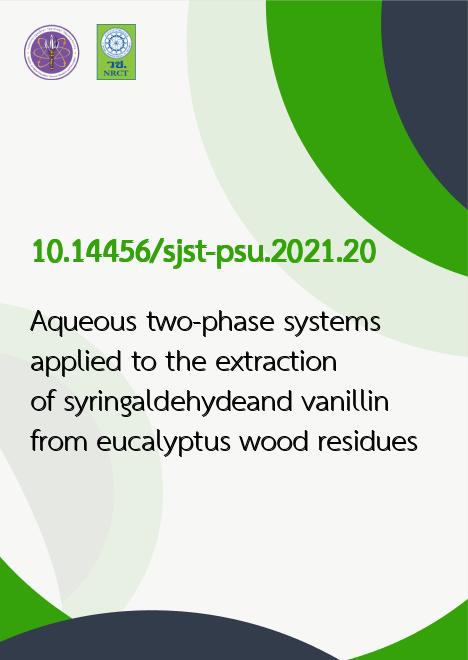
|
Aqueous two-phase systems applied to the extraction of syringaldehydeand vanillin from eucalyptus wood residues |
|---|---|
| รหัสดีโอไอ | |
| Creator | 1. Luc?a Xavier 2. Mar?a Noel Cabrera |
| Title | Aqueous two-phase systems applied to the extraction of syringaldehydeand vanillin from eucalyptus wood residues |
| Publisher | Research and Development Office, Prince of Songkla University |
| Publication Year | 2564 |
| Journal Title | Songklanakarin Journal of Science and Technology (SJST) |
| Journal Vol. | 43 |
| Journal No. | 1 |
| Page no. | 153-159 |
| Keyword | lignocellulosic biorefinery, phenolic compounds, autohydrolysis, aqueous two-phase systems, eucalyptus residues |
| URL Website | https://rdo.psu.ac.th/sjstweb/index.php |
| ISSN | 0125-3395 |
| Abstract | This work examines the recovery of phenolic compounds through the autohydrolysis of eucalyptus wood residues. Thehydrolysis of pin chips was carried out using hot water under different conditions. This treatment was capable of extracting xylosaccharides, phenols, furfural (FUR), hydroxymethylfurfural (HMF) and acetic acid (AAc). The highest phenolic contents wereattained at 160 ?C and 110 minutes, where total phenolic compounds (TPC) reached 1.33% gallic acid equivalent (GAE) andsyringaldehyde (SA) and vanillin (VAN) were at 0.01% each, in pin chips dry basis (d.b.).The capacity to extract phenolic compounds from pin chip hydrolysate through aqueous two-phase systems (ATPS)based on PEG 2000 and sodium citrate was demonstrated. High extraction efficiency was obtained (99.8% for the TPC, 82.3%for the SA, 94.9% for the VAN, 89.3% for the FUR and 70.9% for the AAc). The recovery of sugars in the bottom phase was58.4%. |
